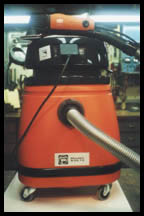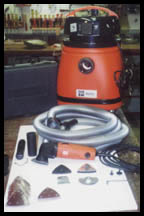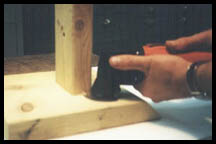

PRODUCT TESTING
FEIN TURBO VAC II &
MULTIMASTER VARIABLE SPEED DETAILING TOOL
by Rob Carr
FIRST IMPRESSIONS
 I consider myself lucky
to be the recipient of one of the "freebies" from Woodworker's
Website Association, Coastal
Tool and Supply and Fein (pronounced Fine) Power Tools, Inc.
I never win anything and usually find myself "a day late
and a dollar short". This wasn't the case one early morning
a few weeks ago as I replied to an e-mail sent by Jim and Chuck
asking who would be interested in testing a Fein MultiMaster
and Fein Turbo Vac. I have received a few of these e-mails in
the past and decided to pass the offers by as I didn't need or
wasn't interested in the offering. My sole source of income is
woodworking and I make primarily smaller, gift-type items. Frames,
breakfast servers, lap desks, small tables, chessboards and assorted
boxes are my main thrust. I felt the Multimaster would benefit
my work as there is quite of bit of detailed sanding required.
I consider myself lucky
to be the recipient of one of the "freebies" from Woodworker's
Website Association, Coastal
Tool and Supply and Fein (pronounced Fine) Power Tools, Inc.
I never win anything and usually find myself "a day late
and a dollar short". This wasn't the case one early morning
a few weeks ago as I replied to an e-mail sent by Jim and Chuck
asking who would be interested in testing a Fein MultiMaster
and Fein Turbo Vac. I have received a few of these e-mails in
the past and decided to pass the offers by as I didn't need or
wasn't interested in the offering. My sole source of income is
woodworking and I make primarily smaller, gift-type items. Frames,
breakfast servers, lap desks, small tables, chessboards and assorted
boxes are my main thrust. I felt the Multimaster would benefit
my work as there is quite of bit of detailed sanding required.
I keep wanting to call the MultiMaster a detail sander because that's what I thought it was. It turns out it is advertised as much more than that. In fact, the slogan on the brochure says..."Finishing is only the beginning". The kit I received has a saw blade and scraper attachment along with a vast assortment of sandpaper. I will get into all that a little later on.
Fein is a German based company which has been in the power tool industry since 1867. They invented the first electrically powered hand drill in 1895 and today produce more than 200 various power tools. For an in-depth look at the company and products, visit their Website at www.fein.com. I lived in Germany as a youngster for three years and came to know, both by experience and my father's comments, the Germans manufacture first class stuff. I anxiously awaited for a couple of fine tools (no pun intended) to arrive at my doorstep.
 One week later
they did. I received a Fein MultiMaster Kit which included the
MultiMaster tool, a hook & loop sanding pad, a 30 pack sandpaper
assortment with grits from 36 to 400, a flush cut saw blade,
a rigid scraper blade, screws and washers for a hook & loop
sanding pad and saw blade, and an allen wrench. This was all
arranged in a plastic carrying case. The other box contained
the Fein Turbo Vac II with 16.4 feet of hose (yes, 16.4 feet!),
4 rubberized swivel wheels and the standard filter bag.
One week later
they did. I received a Fein MultiMaster Kit which included the
MultiMaster tool, a hook & loop sanding pad, a 30 pack sandpaper
assortment with grits from 36 to 400, a flush cut saw blade,
a rigid scraper blade, screws and washers for a hook & loop
sanding pad and saw blade, and an allen wrench. This was all
arranged in a plastic carrying case. The other box contained
the Fein Turbo Vac II with 16.4 feet of hose (yes, 16.4 feet!),
4 rubberized swivel wheels and the standard filter bag.
The very first thing you notice when opening the packages is the orange color of the tools... State Highway Department Orange. I believe it is the same color code. I've noticed that most tool manufacturers today are using some pretty vibrant colors to identify their tool line. Fein is no different. I can guarantee I will not be "hunting around" in my shop for these tools.
The second thing you notice (and are looking for) is the quality workmanship that went into making these tools...attention to detail or, ATD as I call it. That seemed to be there also. The fit and finish we all strive for in our woodworking was present in the tools I received. I decided not "plug and play" right away as I knew I would really get into it and I had a couple of projects I needed to get closer to finishing. So I gathered up all the paperwork (and there was a lot of it) and proceeded to my rocker equipped with my coffee to learn about my new acquisitions. I am definitely a fanatic about reading the directions. I want to know all there is to know about the product. I read them, then I re-read them; and then I file them for future use. There is nothing worse than finding out 2 years down the road that your handy dandy automated grapefruit juicer also makes julienne fries and you went 2 years without that knowledge. I hate it when that happens.
I sorted through all the paperwork and put aside the things I'd get to later, i.e.; warranty information, sales brochure and parts price list. I kept handy the directions for the vac and MultiMaster along with a brochure describing applications and uses. I have to admit that my yearning for information was not at all made easy. The operating instructions for the MultiMaster were in 16 (count them...16) different languages. After locating the English version, it wasn't too painful to decipher, especially because there were only 2 pages of instruction. The "Ideas For Practical Applications" was a different matter. Though it was only printed in 3 languages, it did not flow. As I turned pages looking for the next application, I had to hunt for the English version. The Turbo Vac instructions were written completely in English and were easy to understand. All the brochures, warranties, etc. were also only in English. This "instructions thing" may sound trivial, but it seemed to me that reading and understanding what these tools could and couldn't do was pretty important. If it had been the grapefruit juicer made in China, it would have been different. I think for the money ( about $475.00 retail for both the vac and MultiMaster) the instructions could have been easier to read and follow.
PUTTING THE TOOLS TO THE TEST
When I got ready to do some testing I thought I would perform a few of the operations pictured in the sales brochure. Though I didn't have any old windows to experiment with or linoleum on hand; I improvised with some other items.
FLUSH CUT SAW BLADE.
 I glued a pine
2 x 4 vertically to another board to simulate their depiction
of undercutting a jamb when installing a new floor. The saw blade
is round with a section cut off to allow access into corners
and against flat surfaces. The teeth are not sharp and the brochure
says it can't cut you as it oscillates instead of rotates. Sort
of like the tool doctors remove casts with. The blade is able
to sit flush to a surface as the middle portion is cupped, allowing
the attachment bolt to be elevated away from the blade surface.
I glued a pine
2 x 4 vertically to another board to simulate their depiction
of undercutting a jamb when installing a new floor. The saw blade
is round with a section cut off to allow access into corners
and against flat surfaces. The teeth are not sharp and the brochure
says it can't cut you as it oscillates instead of rotates. Sort
of like the tool doctors remove casts with. The blade is able
to sit flush to a surface as the middle portion is cupped, allowing
the attachment bolt to be elevated away from the blade surface.
I started her up and proceeded to cut into the pine. It was amazingly fast. I cut into 3 sides of the 2 x 4 in 60 seconds (yup, I timed it). Besides the precision of the cut, I was impressed with the fact that the surface I rested the blade on showed no scarring. This was a real plus as it meant I could use it to cut the "ears" off of splines and dowels for miters joints. There is a carbide version of this blade available and is probably worth the investment if serious use is anticipated with something other than pine. Uses for this blade are as endless as the imagination allows; cutting out dried putty from a window, cutting glue beads from a mitered rabbet, furniture restoration, etc. I'll be using this blade more than I thought I would.
POWER SCRAPER
 I must admit the power scraper didn't get the
work-out I wanted it to. The brochure shows it being used for
removing caulking around the tub, removing old paint and lifting
linoleum. After some searching, I came up with a task that I
have been putting off and needed to be done...removing the sandpaper
from a 12" disc sander. I had put 3M spray adhesive on this
last year to hold the paper as I didn't have the glue made for
this application. I wasn't looking forward to getting the paper
off. I clamped the disc in a vise and placed the scraper edge
under the sandpaper. The oscillating action definitely made the
going easier, but I'm not sure I thought I had the control over
the knife that I had with a regular putty knife. I didn't want
to jam the blade in and pry and tug in fear I would break or
bend something. Though the scraper blade is flexible, I still
wasn't comfortable with doing it. I do think however this attachment
will work nicely for caulking. From my experience with linoleum
and paint, the added persuasion of a heat gun would probably
help the task along. Again, I don't feel like I gave this attachment
a fair workout, but it worked okay with what I used it for.
I must admit the power scraper didn't get the
work-out I wanted it to. The brochure shows it being used for
removing caulking around the tub, removing old paint and lifting
linoleum. After some searching, I came up with a task that I
have been putting off and needed to be done...removing the sandpaper
from a 12" disc sander. I had put 3M spray adhesive on this
last year to hold the paper as I didn't have the glue made for
this application. I wasn't looking forward to getting the paper
off. I clamped the disc in a vise and placed the scraper edge
under the sandpaper. The oscillating action definitely made the
going easier, but I'm not sure I thought I had the control over
the knife that I had with a regular putty knife. I didn't want
to jam the blade in and pry and tug in fear I would break or
bend something. Though the scraper blade is flexible, I still
wasn't comfortable with doing it. I do think however this attachment
will work nicely for caulking. From my experience with linoleum
and paint, the added persuasion of a heat gun would probably
help the task along. Again, I don't feel like I gave this attachment
a fair workout, but it worked okay with what I used it for.